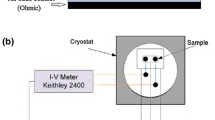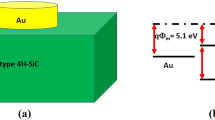Abstract
Photovoltaic effects were tracked on both electric and dielectric properties of Au/(Ni, Zn)-doped polyvinyl alcohol/n-Si Schottky barrier diodes as function of illumination intensity by 50 W steps at 1 MHz and in the voltage interval of (− 4)–(+ 5) V. The measurements indicate that ac electrical conductivity (σ ac ), dielectric constant’s both real and imaginary parts (ε′, ε″), loss tangent (tanδ) and electric modulus (M′, M″) are highly relevant functions of illumination and voltage. The variations in depletion region can be ascribed to the charges at interface and its reordering and restructuring under illumination and electric field but then accumulation region variations can be ascribed to the interfacial layer and series resistance (R s ). The values of εʹʹ and tanδ show a step increase with the increasing voltage for each illumination intensity while the values of ε′ show an anomalous peak (~ 1.4 V). C–V plot shows an intersection behavior at about 2.2 V due to lack of enough free charges in low illumination. The values of σ ac increase with increasing illumination and voltage due to the formation electron–hole pairs. The M″ vs V have two peaks for each illumination intensity and peak value increases with increasing illumination intensity and its positions tend to shift towards low voltage region.







Similar content being viewed by others
References
M. Nakhaei, A.J. Bahari, Mater. Sci.: Mater. Electron. 27, 5899 (2016). https://doi.org/10.1007/s10854-016-4508-3
O. Çiçek, H.U. Tecimer, S.O. Tan, H. Tecimer, Ş. Altındal, I. Uslu, Compos. Part B (2016). https://doi.org/10.1016/j.compositesb.2016.05.042
M. Akbari, A. Etemadi, F. Firoozeh et al., J. Mater. Sci.: Mater. Electron. 28, 11562. (2017). https://doi.org/10.1007/s10854-017-7102-4
T.J. Kempa, B. Tian, D.R. Kim, J. Hu, X. Zheng, C.M. Lieber, Single and tandem axial p-i-n nanowire photovoltaic devices. Nano Lett. 8, 3456 (2008)
Y. Yokoyama, S. Hattori, C. Yoshikawa, Y. Yasuda, H. Koyama, T. Takato, H. Kobayashi, Novel wet electrospinning system for fabrication of spongiform nanofiber 3-dimensional fabric. Mater. Lett. 63, 754 (2009)
P. Viswanathamurthi, N. Bhattarai, H.Y. Kim, D.R. Lee, The photoluminescence properties of zinc oxide nanofibres prepared by electrospinning. Nanotechnology 15, 320 (2004)
M.R. Karim, H.W. Lee, I.W. Cheong, S.M. Park, W. Oh, J.H. Yeum, Conducting polyaniline-titanium dioxide nanocomposites prepared by inverted emulsion polymerization. Polym. Compos. 3(1), 89 (2010)
T. Ogawa, H. Ozawa, M. Kawao et al., J. Mater. Sci.: Mater. Electron. 18, 939. (2007). https://doi.org/10.1007/s10854-007-9262-0
M. Akbari, A. Aetemady, F. Firoozeh et al., J. Mater. Sci.: Mater. Electron. 28, 10245. (2017). https://doi.org/10.1007/s10854-017-6791-z
O. Çiçek, H.U. Tecimer, S.O. Tan, H. Tecimer, İ. Orak, Ş. Altındal, Compos. Part B (2017). https://doi.org/10.1016/j.compositesb.2017.01.012
A.H. Salama, M. Dawy, A.M.A. Nada, Studies on dielectric properties and AC-conductivity of cellulose polyvinyl alcohol blends. Polym. Plast. Technol. Eng. 43(4), 1067 (2004)
T.A. Hanafy, Dielectric relaxation and alternating-current conductivity of gadolinium-doped poly(vinyl alcohol). J. Appl. Polym. Sci. 108, 2540 (2008)
M.A. Ahmed, M.S. Abo-Ellil, Effect of dopant concentration on the electrical properties of polyvinyl alcohol (PVA). J. Mater. Sci.: Mater. Electron. 9, 391 (1998)
S.O. Tan, H. Tecimer, O. Çiçek, IEEE Trans. Electron Devices (2017). https://doi.org/10.1109/TED.2016.2647380
P.B. Bhargav, V.M. Mohan, A.K. Sharma, V.V.R.N. Rao, Structural and electrical properties of pure and NaBr doped poly (vinyl alcohol) (PVA) polymer electrolyte films for solid state battery applications. Ionics 13, 441 (2007)
H. Tecimer, A. Türüt, H. Uslu, Ş Altındal, Temperature dependent current-transport mechanism in Au/(Zn-doped)PVA/n-GaAs Schottky barrier diodes (SBDs). Sens. Actuators A 199, 194 (2013)
H. Uslu, Ş Altındal, İ Dökme, Illumination effect on electrical characteristics of organic-based Schottky barrier diodes. J. Appl. Phys. 108, 104501 (2010)
H.G. Çetinkaya, H. Tecimer, H. Uslu, Ş Altındal, Photovoltaic characteristics of Au/PVA (Bi-doped)/n-Si Schottky barrier diodes (SBDs) at various temperatures. Curr. Appl. Phys. 13, 1150 (2013)
İ Yücedağ, A. Kaya, Ş Altındal, On the frequency dependent negative dielectric constant behavior in Al/Co-doped (PVC + TCNQ)/p-Si structures. Int. J. Mod. Phys. B 28, 1450153 (2014)
W. Jianlong, W.H. Wenhua, Y. Qian, Immobilization of microbial cells using polyvinyl alcohol (PVA)-polyacrylamide gels. Biotechnol. Techn. 9, 203 (1995)
S. Hyon, W. Cha, Y. Ikada, Preparation of transparent poly(vinyl alcohol) hydrogel. Polym. Bull. 22, 119 (1989)
H.H. Wang, T.W. Shyr, M.S. Hu, The elastic property of polyvinyl alcohol gel with boric acid as a crosslinking agent. J. Appl. Polym. Sci. 74, 3046 (1999)
T. Kanaya, M. Ohkura, K. Kaji, M. Furusaka, M. Misawa, Gelation process of poly(vinyl alcohol) as studied by small-angle neutron and light scattering. Macromolecules 27, 609 (1994)
İ Uslu, H. Daştan, A. Altaş, A. Yayli, O. Atakol, M.L. Aksu, Preparation and characterization of PVA/boron polymer produced by an electrospinning technique. e-Polymers 13 (2007)
H.S. Nalwa, Evaluation of electrical conduction in iodine-doped polypyrrole. J. Mater. Sci. 27, 210 (1992)
N.V. Reddy, V.V.R. Narasimha, Effect of iodine on electrical conduction in cellulose acetate-butyrate polymer films. J. Mater. Sci. Lett. 11, 1036 (1992)
A.K. Sharma, V. Adinarayana, D. Shanthisagar, dc-conduction mechanism in Fe-doped polystyrene films. Mater. Lett. 12, 247 (1991)
C.V.S. Reddy, X. Han, Q. Zhu, L. Mai, W. Chen, Dielectric spectroscopy studies on (PVP + PVA) poly blend film. Microelectron. Eng. 83, 281 (2006)
R.F. Bhajantri, V. Ravindrachary, A. Harisha, C. Ranganathaiah, G.N. Kumaraswamy, Effect of barium chloride doping on PVA microstructure: positron annihilation study. Appl. Phys. A 87, 797 (2007)
R.H. Hodge, T.J. Dastow, G.H. Edward, G.P. Simon, A.J. Hill, Free volume and the mechanism of plasticization in water-swollen poly(vinyl alcohol). Macromolecules 29, 8137 (1996)
A. Shehap, R.A. Abd Allah, A.F. Basha, F.H. Abd El-Kader, Electrical properties of gamma-irradiated, pure, and nickel chloride-doped polyvinyl alcohol films. J. Appl. Polym. Sci. 68, 687 (1998)
A.K. Sharma, C. Ramu, D.C. conductivity and I–V characteristics in Fe-doped cellulose acetate films. Mater. Sci. Eng. B 15(3), 222 (1992)
M.M. Mosaad, Dielectric constant study in copper-poly(vinyl alcohol) mixtures. J. Mater. Sci. Lett. 9(1), 32 (1990)
S.O. Tan, H. Uslu Tecimer, O. Çiçek, H. Tecimer, İ Orak, Ş Altındal, J. Mater. Sci: Mater. Electron. (2016). https://doi.org/10.1007/s10854-016-4843-4
H. Guan, C. Shao, Y. Liu, N. Yu, X. Yang, Fabrication of NiCo2O4 nanofibers by electrospinning. Solid State Commun. 131, 107 (2004)
J. Lee, D. Bhattacharyya, A.J. Easteal, J.B. Metson, Properties of nano-ZnO/poly(vinyl alcohol)/poly(ethylene oxide) composite thin films. Curr. Appl. Phys. 8, 42 (2008)
S.O. Tan, H.U. Tecimer, O. Çiçek, H. Tecimer, Ş. Altındal, J. Mater. Sci.: Mater. Electron. (2017). https://doi.org/10.1007/s10854-016-6147-0
Ş Altındal, T. Tunç, H. Tecimer, İ Yücedağ, Electrical and photovoltaic properties of Au/(Ni, Zn)-doped PVA/n-Si structures in dark and under 250 W illumination level. Mater. Sci. Semicond. Process. 28, 48 (2014)
T. Tunç, S. Altındal, İ Uslu, İ Dökme, H. Uslu, Temperature dependent current–voltage (I-V) characteristics of Au/n-Si(111) Schottky barrier diodes with PVA (Ni, Zn-doped) interfacial layer. Mater. Sci. Semicond. Process. 14, 139 (2011)
İ Dökme, Ş Altındal, T. Tunç, İ Uslu, Temperature dependent electrical and dielectric properties of Au/polyvinyl alcohol (Ni, Zn-doped)/n-Si Schottky diodes. Microelectron. Reliab. 50, 39 (2010)
H. Tecimer, H. Uslu, Z.A. Alahmed, F. Yakuphanoğlu, Ş Altındal, On the frequency and voltage dependence of admittance characteristics of Al/PTCDA/p-Si (MPS) type Schottky barrier diodes (SBDs). Compos. Part B 57, 25 (2014)
A. Kaya, H. Tecimer, O. Vural, I.H. Tasdemir, Ş Altındal, Capacitance/conductance-voltage-frequency characteristics of Au/PVC + TCNQ/p-Si structures in wide frequency range. IEEE Trans. Electron Devices 61, 584 (2014)
A. Kaya, O. Vural, H. Tecimer, S. Demirezen, Ş Altındal, Frequency and voltage dependence of dielectric properties and electric modulus in Au/PVC + TCNQ/p-Si structure at room temperature. Curr. Appl. Phys. 14, 322 (2014)
C.P. Symth, Dielectric Behaviour and Structure. (McGraw-Hill, New York, 1955)
V.V. Daniel, Dielectric Relaxation. (Academic Press, London, 1967)
M.M. Bülbül, Frequency and temperature dependent dielectric properties of Al/Si3N4/p-Si(100) MIS structure. Microelectron. Eng. 84, 124 (2007)
İ Dökme, Ş Altındal, M. Gökcen, Frequency and gate voltage effects on the dielectric properties of Au/SiO2/n-Si structures. Microelectron. Eng. 85, 1910 (2008)
M.M. Bülbül, S. Zeyrek, Frequency dependent capacitance and conductance–voltage characteristics of Al/Si3N4/p-Si(100) MIS diodes. Microelectron. Eng. 83, 2522 (2006)
M. Popescu, I. Bunget, Physics of Solid Dielectrics. (Elsevier, Amsterdam, 1984)
C. Fanggao, G.A. Saunders, E.F. Lambson, R.N. Hampton, G. Carini, G.D. Marco, M. Lanza, J. Appl. Polym. Sci. 34, 425 (1996)
A.S.MdS. Rahman, M.H. Islam, C.A. Hogarth, Int. J. Electron. 62(2), 167 (1987)
S.P. Szu, C.Y. Lin, AC impedance studies of copper doped silica glass. Mater. Chem. Phys. 82, 295 (2003)
E.H. Nicollian, J.R. Brews, MOS Physics and Technology. (Wiley, New York, 1982)
Author information
Authors and Affiliations
Corresponding author
Rights and permissions
About this article
Cite this article
Tecimer, H., Tunç, T. & Altındal, Ş. Investigation of photovoltaic effect on electric and dielectric properties of Au/n-Si Schottky barrier diodes with nickel (Ni)–zinc (Zn) doped organic interface layer. J Mater Sci: Mater Electron 29, 3790–3799 (2018). https://doi.org/10.1007/s10854-017-8314-3
Received:
Accepted:
Published:
Issue Date:
DOI: https://doi.org/10.1007/s10854-017-8314-3




